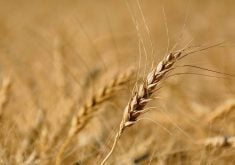By Val Ominski
Protein has always made the wheat world go round, but it became even more important in the mid-1960s when some of the world’s major wheat producers began selling wheat according to protein content.
In response, the Canadian Grain Commission developed a method for segregating wheat based on protein content — thereby increasing the number of samples to be protein tested from about 40,000 to over 500,000 annually.
Testing was done using the century-old Kjeldahl method that was time consuming and sometimes inconsistent — until the Grain Research Lab’s Phil Williams streamlined it and enabled improved precision.
Read Also

CUSMA access key among other trade noise: Seeds Canada panel
Seeds Canada conference panelists say Canada needs to stay focused and wait as U.S. trade and tariff chaos develops, and a Canada-U.S.-Mexico Agreement review looms
Still not satisfied, Williams, an analytical chemist, took the step of investing in an all-new technology. In February 1972, he bought the first near infrared spectroscopy instrument in the world for the CGC.
Unfortunately, it didn’t perform well, he said, so he began working with the American company that produced the instrument to develop an improved version. It was called the automated digital analyzer, and it evaluated 10 samples a minute — compared to a time frame of two hours per sample with the Kjeldahl method.
In 1975, the CGC began using the ADA to test point- of-origin samples. It worked for 18 years, Williams said, and completed 11 million tests.
“In the first year of use, we saved an estimated $350,000,” he said.
Williams continued to work with the manufacturer to develop an updated instrument that could test whole kernels, as opposed to ground samples, and in the early 80s the CGC put the new version into a number of grain terminal elevators in Thunder Bay.
Over the years, Williams worked with various manufacturers as the use of near infrared technology expanded, and has assisted in the calibration and adaption of nearly 50 new instruments.
Under his influence, the CGC converted completely to the newest of the new whole grain instruments in the early 1990s. The rest of the world has followed its lead, and near infrared technology is now a standard international method for protein testing.
“Grading and protein analysis are part of the mosaic of wheat,” Williams explained. “I love it; it’s my life.”
In 2002 he retired from the CGC, but is still active in advancing new technologies in the agriculture industry.


















